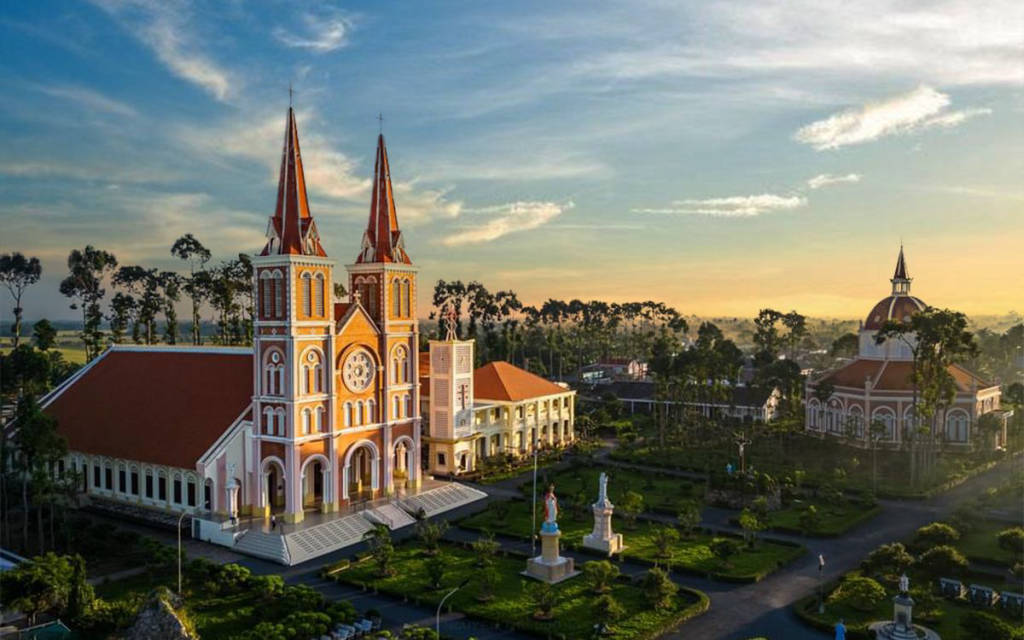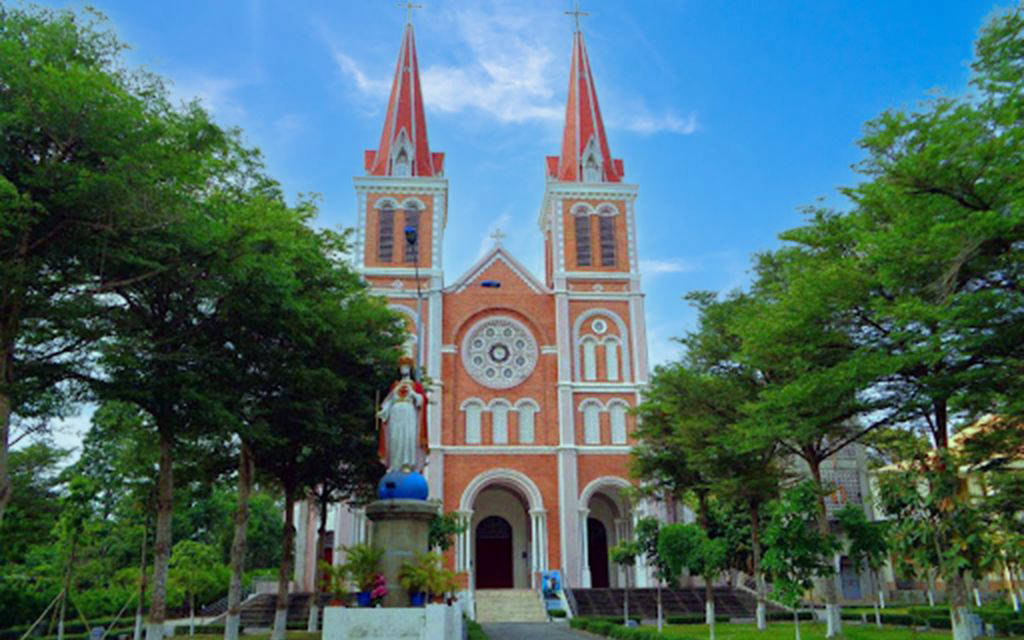Let’s explore Mac Bac Catholic Church, a distinctive religious and architectural landmark located in Cau Quan Town, Tieu Can District, Tra Vinh Province. The church is 30 km from Tra Vinh City and 7 km from Tieu Can Town, both to the southwest, and 3 km east of the left bank of the Hau River. It is not just a symbol of religious culture but also a source of pride for the Catholic community in the Mekong Delta.
The church sits on an expansive plot of over 1 hectare, surrounded by the cool green space of ancient star trees. Its location is particularly strategic, at the center of a raised sandy mound, near the left bank of the Hau River, intersecting key transportation routes, making it accessible by both road and water.
1. Unique Architecture
Mac Bac Church is a harmonious blend of Roman, Gothic, and late 19th-century Vietnamese architectural styles. The church’s design is a scaled-down version (70/100) of the Notre-Dame Cathedral in Saigon, created by French architect J. Bourad. The project was overseen by French engineer Errard, with local leader Nguyen Van Thang serving as the supervisor of construction. A notable feature is the roof, which combines Western church architecture with the design of traditional Vietnamese palace roofs, creating a refined cultural fusion.
Inside the church, visitors will be impressed by the stained glass windows crafted in France, depicting biblical figures and events. These windows not only hold artistic value but also create a mystical light effect, contributing to a peaceful and solemn atmosphere. The altar, located in the sanctuary, is made from a single block of marble and intricately carved with angels and scenes from the Bible. Roman-Gothic chandeliers further enhance the holy and radiant atmosphere.
2. History and Formation
In the 1860s, after the French colonization of Southern Vietnam, Catholic parishes began to operate openly, and the Mac Bac parish gradually expanded toward the central high ground of the sand mound along the Can Chong River, a convenient location for both land and water transport. The French colonial government built a small port at Can Chong to allow French officials from Tra Vinh to visit and attend church services. Thus, the name Cau Quan (Bridge of the Priest) was established, and Mac Bac parish came to be known as Cau Quan Parish.
Construction of the church began in 1886 and was completed in time for Easter 1888. The building measures 24 by 60 meters and features two bell towers, each 32 meters high. All construction materials, including steel, cement, tiles, and a set of six-tone bells (Do, Re, Si, Fa, Sol, La), were shipped from France. This significant investment made Mac Bac Church the second-largest Catholic church in the South at the time, after Saigon’s Notre-Dame Cathedral, earning it the nickname “The Basilica of the Mekong Delta.”
3. Notable Features
In front of the church is a spacious courtyard that stretches the full width of the building. The courtyard is raised 1.2 meters above the church floor and measures 4 meters in width. Originally, there was a square-shaped water pond here, which served both an aesthetic and practical purpose, allowing parishioners to wash their hands and feet before entering the church. While the pond has been filled in today, its historical significance remains etched in the memories of the local people.
The parish house, located to the east of the church, is a two-story structure with wooden stairs and flooring, designed to accommodate the priests and their assistants. It also serves as the venue for important parish meetings.
4. Cultural and Spiritual Value
Mac Bac Church is not only a place of religious practice but also a symbol of unity between the Catholic community and the local people. Over its 130 years of existence, the church has witnessed many historical events and has become a proud cultural heritage of Tra Vinh Province.
5. Conclusion
Dear visitors, a visit to Mac Bac Catholic Church offers a chance to admire an exceptional architectural masterpiece, experience a tranquil atmosphere, and listen to the rich history tied to the Tieu Can region. This will undoubtedly be a memorable experience in your exploration of the Mekong Delta.
We wish you a delightful and fulfilling visit!
 Register
RegisterSign in Travel Agent
Sign in Supplier
Sign in Affiliate
Sign in Guru





 Quốc lộ 60, thị trấn Cầu Quan, huyện Tiểu Cần, Tỉnh Trà Vinh, Việt Nam
Quốc lộ 60, thị trấn Cầu Quan, huyện Tiểu Cần, Tỉnh Trà Vinh, Việt Nam